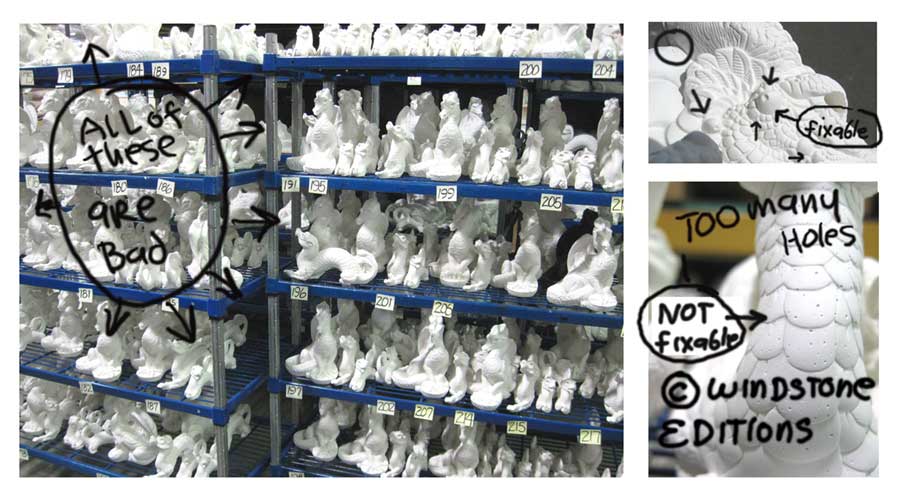
I was asked about our reject pieces by “Nakase” in a thread on the Windstone forum:
http://www.windstoneeditions.com/forums/viewtopic.php?f=10&t=11360
I have been whining about how much trouble we have been having with the gypsum lately, so here are a few photos of what we are dealing with.
I tried to photo the more subtle defects that these pieces are having, but I couldn’t get the camera to focus that tightly. Many of the defects we get on these are often almost microscopic, but they show up under the paint. It is really frustrating to find tiny defects after the piece is completely finished.
(On the bright side, I’ll never run out of raffle prizes!)
Here is a photo of the hundreds of bad pieces we have. Some of these are usable, but most are not.
This looks worse than it really is though; John was intentionally trying to make bad castings as a way to help isolate the problem. That’s why we have ended up with carts and carts of bad pieces, but we still are getting far to many bad pieces when we try to cast good ones.
Since I couldn’t photo the tiny defects, I posted a photo here of some very obvious holes that make the piece unusable on the chest of an Oriental dragon. There are so many holes on this one, it would be impossible to patch this piece.
Another photo of the neck of a Male dragon shows the sort of holes that we can and do fix.
We need a priest to exorcise the casting department!

It seems to me that something must be causing the bubbles to form in the mixture itself. My guess is that if it’s a matter of chemistry, it might be a matter of pH. It might also be just a matter of too much air caught in the water used to mix up the gypsum. Cold water has gases trapped in it (lots of oxygen for cold-water fishes!) One way to avoid gases leaving the water after casting is make sure they’ve left BEFORE casting. That is, leave your water out to just sit for a few days before using it. This will naturally let the gases escape. It also might bring the pH to its natural level…which might be significantly lower than straight out of the tap. Another thing you might try is agitating the water and/or gypsum mixture before casting. I used to have to do this in the lab when working with DNA gels. If we didn’t just spin a stir bar in it for a good amount of time before adding the polymerizing agent, we would get bubbles. You can also do this by setting it on a vibrating surface. The bubbles escape to the surface and don’t make bubbles when you cast. In the back of my mind, I KNOW that there’s an industry that uses vibration to reduce bubbles and imperfections….ice, maybe? Anyway, it might be worth trying.
When in jewelry casting, with the lost wax casting technique, we have to use a vaccum chamber, to get all the bubbles out of it. Could this possibly help you guys? Maybe a vibrating platform, like when you cast concrete? (the cheaper way) Or use a hand vibrator and hold it to the mold? Maybe have one of your casting folks do that and see what happens??
Also, moving from North Hollywood to Oregon you went from dry hot to wet hot, so a -dehumidifier- in your casting department might fix your problem o_o (discussing the troubleshooting process of this problem with Pyewacket)
Bless you and the Windstone folks o_o that is a LOT of product that is unusable(not to mention and huge whack in the face money-wise)…and very heartbreaking in that I wish I could have one of those oriental dragons….I’m seriously going to stop whining about it, after seeing all those poor things sitting there ready to be smashed…
I’m sure I speak for everyone in that; We’re all here ready to brainstorm possible solutions for this nasty problem. <3<3<3
Ack! What a sad sight! Seeing all those dragons destined to be destroyed. I can’t even imagine how frustrating it must be for the staff who spent all that time and effort on making them. I hope you figure out the problem soon.
This is a problem for the chemists at the gypsum manufacturing company to solve. We have tried everything we could think to try, and still are having problems.
The thing is, we are casting the way we have been for over twenty years, with good results. Now it doesn’t work. It must be the formulation of the gypsum. We think there is some stray chemical in there that wasn’t there before.. One chemist mentioned the possibility of calcium carbonate being in the gypsum. That would fizz in an acid, but our water is alkaline!
Thank you !
How frustrating. Yes, alkaline water shouldn’t make calcium carbonate fizz. I hope all that gypsum has been free for the change in the formula. It’s too bad you can’t have someone cast back in CA to see if it’s casting fine there. How hard is your water? Excess salts have been known to cause bubbles, I believe.
oh my gosh!!
I would LOVE to be in that room – with all the paints… Experimenting with colors, textures and more – that would just be a DREAM!